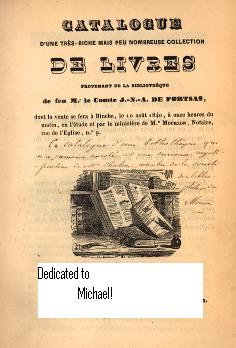Invisible Library from Belgium: the Fortsas Catalogue January 9, 2013
Author: Beach Combing | in : Modern , trackbackThe Fortsas Catalogue, printed in 1840 has within its pages one of the greatest invisible libraries ever written: an invisible library being a collection of book that have never existed outside an author’s imagination.
The catalogue itself is real enough: a few (very valuable) copies are still to be found, but the namesake of the catalogue the recently deceased Jean Népomucène Auguste Pichauld, Comte de Fortsas was a mask for Renier Hubert Ghislain Chalon (obit 1889) an ingenious Belgian book seller. Chalon knew, of course, just how enthusiastic collectors are and decided that he would create a list of invented unique titles to hang, like the most succulent bait imaginable, over the carp pond. To this end, he penned the following introduction pretending to be an anonymous seller. It is a masterpiece:
The Count de Fortsas admitted upon his shelves only works unknown to all bibliographers and cataloguers. It was his invariable rule, a rule from which he never departed. With such a system, it is easy to conceive that the collection formed by him — although during forty years he devoted considerable sums to it — could not be very numerous. But what it will be difficult to believe is, that he pitilessly expelled from his shelves books for which he had paid their weight in gold — volumes which would have been the pride of the most fastidious amateurs — as soon as he learned that a work, up to that time unknown, had been noticed in any catalogue. This sad discovery was indicated upon his manuscript list in a column devoted. The publication of the Nouvelles Recherches of Brunet was a severe blow for our bibliomaniac, and one which, without doubt, contributed to hasten his end. It made him lose at once the third of his cherished library. After that he seemed disgusted with books and with life; he did not make a single further acquisition; but the Bulletin of Techener from time to time still further thinned the already decimated ranks of his sacred battalion.
Beach knows this is a fake and yet it still got him salivating.
There were fifty-two titles that the author claimed stood on the shelves of Fortsas’s library. Chalon put the list together in such a way as to tempt book collector from across the continent: only 132 copies of the catalogue were actually printed but it was enough to send those who received a copy into ecstasy. Each book had to be credibly obscure and it was better still if there was a back story explaining why there was only one copy. Take the punning Poems of Poisson (Poësies de Carême [du Sieur Poisson] à la Trappe, chez Lafriture). Poisson liked, according to the catalogue, satirical verse and had so annoyed the local authorities that they had suppressed his book. Fortsas claimed that he had got the last surviving copy from Poisson’s descendants.
There was also humour: Les suites du plaisir, ou desconfiture du Grand Roi dans les Pais-Bas. Au Ponent (Hollande), 1686. [The places of Pleasure or the Discomforture of the Great King in the Low Country] ‘Fortsas’ had written this note on the book:
A libel of a disgusting cynicism on occasion of the fistula of Louis XIV. One of the plates represents the royal backside under the form of a fan surrounded with rays, with the famous motto: Nec pluribus impar [not unequal to many].
The sale was due to be held in the obscure town of Binche in southern Belgium, 10 August. But as collectors from France and Belgium descended on this municipality the confusion began. First of all, the ‘Church Road’ where the auction was to be held did not exist. Second, on the morning of the auction a notice in the newspaper announced that the books would not be sold but they would be given to the Binche’s public library: but Binche had no public library…
Any other Invisible Libraries: drbeachcombing AT yahoo DOT com



